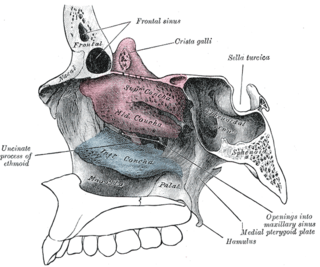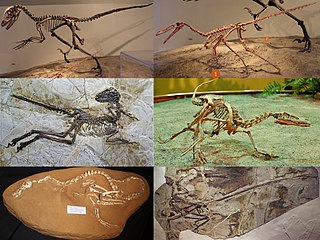John A. Ruben is a researcher in Zoology and Vertebrate paleontology at the Oregon State University in Corvallis. Much of his published research is focused on studying the respiratory system in birds, in order to contradict the theory of theropodan ancestry of birds, as well as their metabolism.
Ruben has questioned for many years the theory that birds descend from small carnivorous dinosaurs of suborder Theropoda. He suggest theropods had a diaphragma driven respiratory system which could not have evolved into the complex air sacs in birds (but the presence of air sacs in saurischian dinosaurs has been demonstrated by highly pneumatic fossil bones of e.g. Aerosteon and Tataouinea ). While some have claimed Ruben's research to be flawed, his papers have, nevertheless, appeared in highly regarded, heavily peer-reviewed journals such as Science, Nature and the Journal of Morphology. He has done some research on the dinosaurs Scipionyx [1] and Sinosauropteryx , [2] [3] from which he gives his arguments. Ruben also took part in the 2009 discovery of a close correlation between the immobilized thighbone and complex respiratory systems in birds. [4] [5]
Research on the fossil animal Microraptor has also led Ruben to suggest that Dromaeosauridae, for a long time regarded as feathered dinosaurs, actually represent flightless descendants of older birds, [6] as he said: "We think the evidence is showing that these animals which are usually considered dinosaurs were actually descended from birds, not the other way around". [7] Ruben sees it more possible that perhaps a creature like the diapsid reptile Longisquama represents the ancestor to birds. [8]

Troodontidae is a family of bird-like theropod dinosaurs. During most of the 20th century, troodontid fossils were few and incomplete and they have therefore been allied, at various times, with many dinosaurian lineages. More recent fossil discoveries of complete and articulated specimens, have helped to increase understanding about this group. Anatomical studies, particularly studies of the most primitive troodontids, like Sinovenator, demonstrate striking anatomical similarities with Archaeopteryx and primitive dromaeosaurids, and demonstrate that they are relatives comprising a clade called Paraves.

Archosauria is a clade of diapsids, with birds and crocodilians as the only living representatives. Archosaurs are broadly classified as reptiles, in the cladistic sense of term which includes birds. Extinct archosaurs include non-avian dinosaurs, pterosaurs, and extinct relatives of crocodilians. Modern paleontologists define Archosauria as a crown group that includes the most recent common ancestor of living birds and crocodilians, and all of its descendants. The base of Archosauria splits into two clades: Pseudosuchia, which includes crocodilians and their extinct relatives, and Avemetatarsalia, which includes birds and their extinct relatives.

In anatomy, a nasal concha, plural conchae, also called a nasal turbinate or turbinal, is a long, narrow, curled shelf of bone that protrudes into the breathing passage of the nose in humans and various animals. The conchae are shaped like an elongated seashell, which gave them their name. A concha is any of the scrolled spongy bones of the nasal passages in vertebrates.

Dromaeosauridae is a family of feathered theropod dinosaurs. They were generally small to medium-sized feathered carnivores that flourished in the Cretaceous Period. The name Dromaeosauridae means 'running lizards', from Greek δρομεῦς (dromeûs), meaning 'runner', and σαῦρος (saûros), meaning 'lizard'. In informal usage, they are often called "raptors", a term popularized by the film Jurassic Park; a few types include the term "raptor" directly in their name and have come to emphasize their bird-like appearance and speculated bird-like behavior.

Sinosauropteryx is a compsognathid dinosaur. Described in 1996, it was the first dinosaur taxon outside of Avialae to be found with evidence of feathers. It was covered with a coat of very simple filament-like feathers. Structures that indicate colouration have also been preserved in some of its feathers, which makes Sinosauropteryx the first non-avialian dinosaurs where colouration has been determined. The colouration includes a reddish and light banded tail. Some contention has arisen with an alternative interpretation of the filamentous impression as remains of collagen fibres, but this has not been widely accepted.

Microraptor is a genus of small, four-winged dromaeosaurid dinosaurs. Numerous well-preserved fossil specimens have been recovered from Liaoning, China. They date from the early Cretaceous Jiufotang Formation, 125 to 120 million years ago. Three species have been named, though further study has suggested that all of them represent variation in a single species, which is properly called M. zhaoianus. Cryptovolans, initially described as another four-winged dinosaur, is usually considered to be a synonym of Microraptor.

Scipionyx is a genus of theropod dinosaur from the Early Cretaceous of Italy, around 113 million years ago.

Unenlagia is a genus of dromaeosaurid theropod dinosaur that lived in South America during the Late Cretaceous period. The genus Unenlagia has been assigned two species: U. comahuensis, the type species described by Novas and Puerta in 1997, and U. paynemili, described by Calvo et al. in 2004.
Air sacs are spaces within an organism where there is the constant presence of air. Among modern animals, birds possess the most air sacs (9–11), with their extinct dinosaurian relatives showing a great increase in the pneumatization in their bones. Theropods, like Aerosteon, have many air sacs in the body that are not just in bones, and they can be identified as the more primitive form of modern bird airways. Sauropods are well known for the number of air pockets in their bones, although one theropod, Deinocheirus, shows a rivalling number of air pockets.

Longisquama is a genus of extinct reptile. There is only one species, Longisquama insignis, known from a poorly preserved skeleton and several incomplete fossil impressions from the Middle to Late Triassic Madygen Formation in Kyrgyzstan. It is known from the type fossil specimen, slab and counterslab and five referred specimens of possible integumentary appendages. All specimens are in the collection of the Paleontological Institute of the Russian Academy of Sciences in Moscow.

The evolution of birds began in the Jurassic Period, with the earliest birds derived from a clade of theropod dinosaurs named Paraves. Birds are categorized as a biological class, Aves. For more than a century, the small theropod dinosaur Archaeopteryx lithographica from the Late Jurassic period was considered to have been the earliest bird. Modern phylogenies place birds in the dinosaur clade Theropoda. According to the current consensus, Aves and a sister group, the order Crocodilia, together are the sole living members of an unranked reptile clade, the Archosauria. Four distinct lineages of bird survived the Cretaceous–Paleogene extinction event 66 million years ago, giving rise to ostriches and relatives (Paleognathae), ducks and relatives (Anseriformes), ground-living fowl (Galliformes), and "modern birds" (Neoaves).
The Portezuelo Formation is a geologic formation of Late Cretaceous age, outcropping in the Mendoza, Río Negro and Neuquén provinces of Argentina. It is the fourth-oldest formation in the Neuquén Group and the older of the two formations in the Río Neuquén Subgroup. Formerly, that subgroup was treated as a formation, and the Portezuelo Formation was known as the Portezuelo Member.
The physiology of dinosaurs has historically been a controversial subject, particularly their thermoregulation. Recently, many new lines of evidence have been brought to bear on dinosaur physiology generally, including not only metabolic systems and thermoregulation, but on respiratory and cardiovascular systems as well.

The scientific question of within which larger group of animals birds evolved has traditionally been called the 'origin of birds'. The present scientific consensus is that birds are a group of maniraptoran theropod dinosaurs that originated during the Mesozoic Era.

Maniraptoriformes is a clade of dinosaurs with pennaceous feathers and wings that contains ornithomimosaurs and maniraptorans. This group was named by Thomas Holtz, who defined it as "the most recent common ancestor of Ornithomimus and birds, and all descendants of that common ancestor."

Paraves are a widespread group of theropod dinosaurs that originated in the Late Jurassic period. In addition to the extinct dromaeosaurids, troodontids, anchiornithids, and scansoriopterygids, the group also contains the avialans, among which are the over ten thousand species of living birds. Early members of Paraves are well known for the possession of an enlarged claw on the second digit of the foot, which was held off the ground when walking in some species.

Aerosteon is a genus of megaraptoran dinosaur from the Late Cretaceous period of Argentina. Its remains were discovered in 1996 in the Anacleto Formation, which is from the late Campanian. The type and only known species is A. riocoloradensis. Its specific name indicates that its remains were found 1 km north of the Río Colorado, in Mendoza Province, Argentina.

Tawa is a genus of possible basal theropod dinosaurs from the Late Triassic period. The fossil remains of Tawa hallae, the type and only species were found in the Hayden Quarry of Ghost Ranch, New Mexico, US. Its discovery alongside the relatives of Coelophysis and Herrerasaurus supports the hypothesis that the earliest dinosaurs arose in Gondwana during the early Late Triassic period in what is now South America, and radiated from there around the globe. The specific name honours Ruth Hall, founder of the Ghost Ranch Museum of Paleontology.

Unenlagiidae is a proposed family of eumaniraptoran paravians that includes the subfamilies Unenlagiinae and possibly Halszkaraptorinae. Fossils of both subfamilies have been found in both Gondwanan and Laurasian deposits. The biology of the group suggests that some members were semiaquatic specialists.

Overoraptor is a genus of paravian theropod dinosaurs, which was closely related to Rahonavis, from the Late Cretaceous (Cenomanian) Huincul Formation of Gondwana, present-day Argentina. It includes one species, Overoraptor chimentoi.